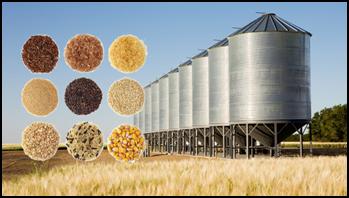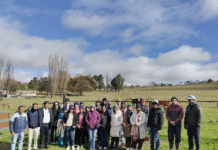
India’s agricultural sector reached a record food grain production of 353.96 million tons in 2024–25, showcasing the scale and resilience of its farming systems. However, effectively managing this output requires more than just cultivation; it necessitates robust storage infrastructure to preserve quality, minimize losses, and ensure timely distribution.
Both centralized and decentralized storage systems, along with cold chain networks, play vital roles in maintaining food security, stabilizing prices, and supporting farmers’ incomes.
Centralized storage is primarily overseen by the Food Corporation of India (FCI), which procures grains such as wheat and rice at minimum support prices (MSP) and stores them in covered warehouses and steel silos. These stored grains are then distributed through the public distribution system (PDS) or transferred between states as required.
As of July 2025, the combined capacity for covered and CAP (cover and plinth) storage stood at 91.78 million metric tons. CAP storage involves placing grains on elevated platforms with protective materials, while covered storage consists of fully enclosed godowns and silos. These facilities help maintain buffer stocks, ensuring a year-round availability of essential commodities.
In addition to grain storage, cold storage infrastructure preserves perishable items such as fruits, vegetables, dairy products, meat, and seafood. By June 2025, India had 8,815 cold storage facilities with a total capacity of 40.22 million metric tons. These included pre-cooling units, sorting and grading stations, blast freezers, and refrigerated transport options.
Financial support for the development of cold chain infrastructure is available through programs such as the Pradhan Mantri Kisan SAMPADA Yojana (PMKSY) and the Agriculture Infrastructure Fund (AIF). Additionally, the Capital Investment Subsidy Scheme offers credit-linked subsidies of 35–50% for cold storage projects in eligible regions, assisting farmers and entrepreneurs in extending shelf life and improving market access.
Decentralized storage, introduced in 1997-98, allows state governments to procure, store, and distribute food grains locally under the National Food Security Act (NFSA) and various welfare programs. Primary Agricultural Credit Societies (PACS) play a central role in this model by offering village-level storage capacities ranging from 500 to 2,000 metric tons. PACS also serve as procurement centers and Fair Price Shops (FPS), helping to reduce transportation costs and improve distribution efficiency. A computerization project with an outlay of Rs 2,516 crore has been implemented to enhance PACS operations. As of June 2025, 73,492 PACS have been computerized, and 5,937 new PACS have been registered.
Several infrastructure schemes support storage expansion. Under the AIF, Rs 73,155 crore has been sanctioned for 1.27 lakh projects, including warehouses and cold storage facilities. The Agricultural Marketing Infrastructure (AMI) scheme has approved 49,796 projects across 27 states, creating 98.29 million metric tons of storage capacity. PMKSY has supported 1,601 projects, with 1,133 currently operational, adding 25.57 million metric tons of processing capacity annually. In May 2023, the world’s largest grain storage initiative was launched to build infrastructure at the PACS level. As of August 2025, godowns have been completed in 11 PACS across 11 states, with over 500 more identified for expansion.
Modernization efforts include the construction of steel silos, which provide automated, monitored environments for bulk grain storage. As of June 2025, silos at 48 locations (totaling 2.78 million metric tons) are operational, 87 locations (3.69 million metric tons) are under construction, and tenders for 54 locations (2.51 million metric tons) are in process.
Asset monetization is also progressing, with 177 FCI-owned sites identified for the construction of new godowns totaling 1.75 million metric tons of capacity. The Private Entrepreneurs Guarantee (PEG) scheme, launched in 2008, encourages private investment in warehousing through guaranteed hiring under the PPP model.
India’s agricultural strength lies not only in production but also in the systems that preserve and distribute its output. As demand grows and climate challenges increase, resilient and scalable storage infrastructure will remain essential to ensure that every harvested grain reaches its destination—safely, efficiently, and sustainably.
Proper storage plays an important role in preventing food waste. Keeping these aspects in mind, the Food Tek Pack conference in Greater Noida on 11 and 12 December, organized by IPPStar, aims to look at the food supply chain and its processing and packaging needs in a holistic way as a part of the Indian Save Food movement.
(This article is based on publicly available data from the Press Information Bureau, Government of India. Original press release dated September 28, 2025: “From Harvest to Home – Building Resilient Infrastructure for Storage of Food Grains” (https://www.pib.gov.in/PressReleseDetailm.aspx?PRID=2172351).
IndiFoodBev — authentic, impactful and influential
An English-language food and beverage processing and packaging industry B2B platform in print and web, IndiFoodBev is in its third year of publication. It is said that the Indian food and beverage industries represent approximately US$ 900 billion in revenues which implies more than 20% of the country’s GDP. Eliminating the wastage on the farmside can help to deliver more protein to a higher number of the population apart from generating sizable exports. The savings in soil, seeds, water, fertilizer, energy and ultimately food and nutrition could be the most immense contribution that country is poised to make to the moderation of climate change.
To improve your marketing and grow sales to the food and beverage processing and packaging industry, talk to us. Our research and consulting company IppStar [www.ippstar.org] can assess your potential and addressable markets in light of the competition. We can discuss marketing, communication, and sales strategies for market entry and growth.
Suppliers and service providers with a strategy and budget for targeted marketing can discuss using our hybrid print, web, video, and social media channels to create brand recognition linked to market relevance. Our technical writers are ready to meet you and your customers for content.
The second largest producer of fruit and vegetables in the world is continuously expanding processing capacities and delivery systems with appropriate innovative technologies. We cover product and consumer trends, nutrition, processing, research, equipment and packaging from farm to thali. Get our 2025 media kit and recalibrate your role in this dynamic market. Enhance your visibility and relevance to existing markets and turn potential customers into conversations. Ask for a sample copy of our bi-monthly in print or our weekly IndiFoodBev eZine each Wednesday.
For editorial info@ippgroup.in — for advertisement ads1@ippgroup.in and for subscriptions subscription@ippgroup.in
Naresh Khanna – 10 February 2025
Subscribe Now











